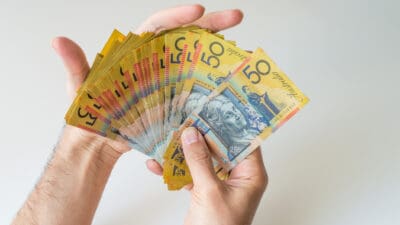Passive income comes in from your investments while you sleep, and it's arguably easier to generate if you buy ASX shares vs. property.
This is because investors can start small with ASX shares and buy a portfolio over time using savings rather than debt. The other advantage is there are no holding costs for shares investments whatsoever.
If you want to buy a real estate investment, odds are you'll need a loan, and on top of that, there are thousands of dollars in holding costs, such as insurance, strata levies and council rates.
Let's take a look at how it works.
Our aim will be to generate $500 passive income per month from investing in ASX shares vs. property.
Shares vs. property: $500 per month passive income
For property investors, achieving positive cash flow (rental income less costs) is really hard.
This is because property investment typically involves taking out a loan because home values are so high.
And with investment loan rates at about 7% these days, it's very hard for an investor on a typical 80:20 loan-to-value ratio (LVR) loan to generate positive passive income at all.
The loan repayments alone typically exceed the rental income. This is why most of Australia's 2.25 million landlords are negatively geared, according to the latest Australian Tax Office data.
A near-40% increase in weekly rents since August 2020 has certainly helped. But interest rates have gone up 13 times since May 2022 and this has had a greater impact for most investors.
Let's look at a case study to see how we can achieve $500 per month in positive passive income (i.e., after costs) from real estate investment.
Case study: The cheap property
Buying property in a cheaper market is one strategy you could employ to generate positive passive income sooner.
The cheapest market in terms of median house prices is regional South Australia at $407,655, according to CoreLogic figures.
Regional South Australia has a gross rental yield of 5%. That's $20,383 per year in rental income (check out the yields in other regional and metro markets here).
We'll assume about $7,000 in ongoing holding costs per year covering council and water rates, insurance, repairs, property management fees, and a multitude of small costs like annual pest inspections.
In terms of home loan repayments, the lowest standard variable investment mortgage interest rate advertised on RateCity at the time of writing is 6.96% (on interest-only terms).
On an 80:20 loan (hence finance of $326,124), RateCity calculates the monthly loan repayments to be $1,892, or $22,704 per year. So, the loan repayments alone exceed your rental income.
Let's halve that loan amount (hence finance of $163,062). The repayment is $946 per month or $11,352 per year. Now we have a chance at some positive passive income.
$20,383 per year in rent less $11,352 interest less $7,000 holding costs = $2,031 positive cash flow. But that's only $169 per month in positive passive income, so well off our target of $500.
How about we halve that loan amount again (hence finance of $81,531). The repayment is $540 per month or $6,480 per year. Does that bring us close?
$20,383 per year in rent less $6,480 interest less $7,000 holding costs = $6,903 positive cash flow. So now we're getting $575 per month of positive passive income.
But in order to achieve this, you'd need $326,124 in savings (and $81,531 in debt) to buy the asset in the first place.
It's worth noting that interest payments and holding costs are generally tax deductible. Shares also deliver a tax benefit via franking. We're excluding these tax benefits to keep our calculations simple.
The bottom line from this case study: To achieve $500 per month positive passive income, you'll likely either need to buy a cheap investment property, or buy with less finance, or both.
Passive income via dividends
The average dividend yield for S&P/ASX 200 Index (ASX: XJO) shares is 4% per annum. But you can do better than that if you invest in some of the best income shares on the ASX.
Let's take a look at a few examples.
| ASX 200 share | Dividend yield |
| BHP Group Ltd (ASX: BHP) | 5.42% |
| National Australia Bank Ltd (ASX: NAB) | 4.86% |
| Westpac Banking Corp (ASX: WBC) | 5.47% |
| ANZ Group Holdings Ltd (ASX: ANZ) | 5.55% |
| Fortescue Ltd (ASX: FMG) | 8.19% |
If you were to buy Fortescue shares with the aim of generating $500 per month passive income (on average spread over two dividend payments per year), you'd need to have $73,260 in savings to buy the asset in the first place.
Shares vs. property
So, when it comes to shares vs. property and generating $500 per month in passive income, our case studies show that shares appear to be an easier investment strategy for achieving this particular goal.









